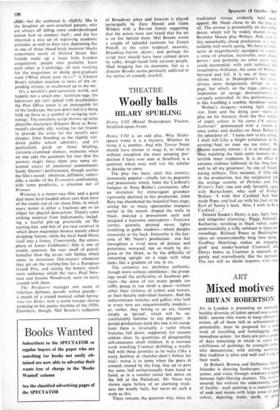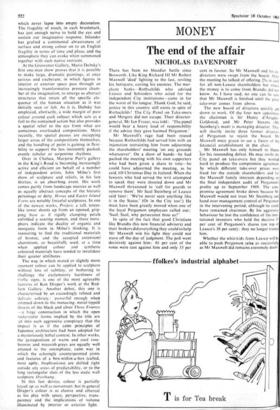ART
Mixed motives
BRYAN ROBERTSON
Art in London is presenting an unusually healthy diversity of talent spread over a wide field: anyone who wants to keep abreast of events, all of them rich in achievement or potentiality, must be prepared for a solid week of travelling and footslogging. And immediate action : for there are just a couple of days remaining in which to catch two exhibitions of paintings by youngish artists who demonstrate, with stirring authority. that tradition is alive and well and living in their work.
At Roland, Browse and Delbanco. Ho! Inlander is showing landscapes, river-bank scenes, and vistas through windows trapped between light-filtering shutters. The work'' assured, but without the undermining sense of facility : each painting is a concentration of ends and means with large areas of pu colour, depicting water, earth, or gr
which never lapse into empty decoration. The frugality of touch, in each brushmark, has just enough nerve to hold the eye and sustain our imaginative response. Inlander has grafted a continental abrasiveness of surface and strong colour on to an English fragility in terms of time and place, and the atmosphere they can evoke when summoned together with such native restraint.
At the Grosvenor Gallery, Mario Dubsky's first one-man show proves that it is possible to make large, dramatic paintings, at once serious and exuberant, in which figures in interior or exterior space pass through an increasingly transformative pressure cham- ber of the imagination, to emerge as abstract structures that retain all the specific elo- quence of the human situation as it was initially seen or felt. As it is, Dubsky has employed, abstractly, a wide margin of pure colour around each subject which acts as a foil to the contained action but also provides a spatial relief to the eye from what are sometimes overloaded compositions. More recently, the spatial pauses are occupying larger areas of the compositions themselves, and the handling of paint is gaining in flexi- bility to support the less insistently packed, evenly tubular or serpentine rhythms.
Over in Chelsea, Marjorie Parr's gallery in the King's Road is becoming increasingly active and efficient on behalf of a number of independent artists. John Milne's first show of sculpture and reliefs, in his late thirties, is an absorbing event. His work comes partly from landscape sources as well as equally abstract concepts of the hieratic personage or deity. Horus and Easter Island Form are notably forceful sculptures. In one of the newest .works, Project, a tall, totem- like tower shoots up from an opened, grip- ping base as if rigidly clamping petals enfolded a soaring stamen, and these meta- phors indicate the duality of organic and inorganic form in Milne's thinking. It is reassuring to find the traditional materials of bronze, and (by accepted extension) aluminium, so beautifully used, at a time when applied colour and synthetic coloured materials have tended to invalidate their quieter attributes.
The way in which muted or slightly more resonant colour can be applied to sculpture without loss of subtlety, or bothering to challenge the exclamatory harshness of traffic signs, is one of the most agreeable feattlees of Ken Draper's work at the Red- fern Gallery. Another debut, this one is characterised by an exceedingly refined and delicate sobriety : powerful enough when stripped down to the menacing, metal-tipp&i thrusts of the black and silver Three Frames —a large construction in which the open rectangular forms implied by the title are set into such aggressive conspiracy that the impact is as if the calm principles of Japanese architecture had been adopted for a mysteriously lethal context. In other works, the juxtaposition of warm and cool rose- browns and mauvish-greys are equally well attuned to the unemphatic, calm way in which the echoingly counterpointed joints and features of a box-within-a-box (called, most aptly, Implications) are shifted right outside any areas of predictability, or to the long rectangular slats of the less static wall sculpture Overhang.
In this last device, colour is partially keyed up as well as movement; but in general Draper's colour is as elusive and ethereal as his play with space, perspective, trans- parency and the implications of volume illuminated by interior or exterior light.



































 Previous page
Previous page